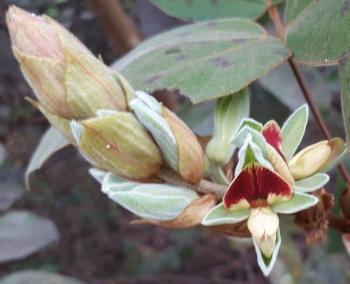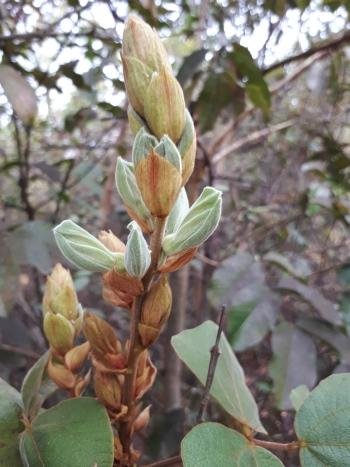Rhynchosia hirta
Rhynchosia hirta (Andr.) Meikle & Verdc.
Family: Fabaceae
Common names: blue-seeded snoutbean, hairy snoutbean (Eng.); imbelekisani, iyezalesisu (Xho.)
Introduction
A lovely indigenous vine with attractive blue seeds; an alternative to gardeners over exotics.

Description
Description
Rhynchosia hirta is a vigorously twining or climbing herbaceous, sometimes woody plant, of various sizes, but reaching heights of 2–8 m. Stems are densely covered with short brownish hairs when young. These hairs fall off as the plant matures. Leaves are trifoliolate (with three leaflets), broadly elliptic to ovate, with simple margins, sparsely hairy above, densely covered with reddish brown hairs beneath.

Flowering stalk is occasionally branched, with 7-many flowers. Flowers vary from greenish cream-coloured, to yellow, striped with red; through orange to pink with red or purple venation that sometimes give them a reddish appearance. It flowers from late winter throughout spring to summer (July–March).

The 2-seeded pods (fruit) are narrowly oblong, densely covered in short, velvety grey or rusty-brown hairs. Pods open and twist upon seed maturity, exposing the glossy dark-blue seeds that remain attached to the pods.
Conservation Status
Status
Rhynchosia hirta has a wide distribution and is commonly found. Its status is, therefore, considered Least Concern (LC).
Distribution and habitat
Distribution description
Rhynchosia hirta occurs in far northwestern parts of South Africa, from KwaZulu-Natal through to Mpumalanga and Limpopo Provinces. It further spreads northwards into East and Central Africa and westwards into Cameroon, northern Nigeria and Ivory Coast, and further east to the Mascarene Islands, India and Sri Lanka. It grows in sandy soil in grasslands, rocky outcrops, open woodlands, forest margins and occasionally on termite mounds. In Zimbabwe, it is recorded to occur in Brachystegia woodlands. In South Africa, Rhynchosia hirta grows at altitudes of 150–1 800 m.
Derivation of name and historical aspects
History
The genus name Rhynchosia is derived from a Greek word rhyncos, meaning ‘beak’, referring to the beaked pod of some species in the genus, for example those of Rhynchosia caribaea and many others. The keel (the 2 often partially united lowest petals that conceal the sexual parts of the flower) of the flowers is also beaked. The specific name hirta, means ‘hairy’, referring to the hairiness of the plant (stems, leaves, calyces and fruits).
The genus was first described in 1790 by Loureiro for the inclusion of R. volubilis and since then, more than 235 species have been described of which 73 occur in southern Africa.
Ecology
Ecology
Rhynchosia hirta is very hairy, and for this reason it is said to be unpalatable to grazing animals and preying insects; however, birds such as guinea-fowl and francolin eat the seeds in Kenya.
Uses
Use
Rhynchosia hirta is an important medicinal plant, especially in Tanzania, where it is used an ecbolic (in childbirths) and in puerpuerium disorders. Roots are used as a famine food. The stem is used in agri-horticulture for fodder and also as fibre, or string. Leaves are used as a tonic, as well as in stomach disorders. In the southern peninsula of India seeds are used as food by the local people in the Udayagiri Forest of the Nellore District, Andhra Pradesh State. The Zingua locals in Tanzania use the seed pods as rattles, as well as decorating children toys.
Growing Rhynchosia hirta
Grow
It is a fast grower in the natural habitat. When cultivating this plant from seeds, 90% germination can be achieved, by pre-sowing scarified seeds (chipped with scalpel), imbibed on 1% agar germination medium for 70 days at 30/15°C (Them 8/16) [meaning, seed sown in the light for 8 hours at 30°C, and in the dark for 16 hours at 15°C ]. The plant can be best used in the gardens as a decorative climber along fences. The plant tolerates light shade, but flowers better in full sun.
References
- Amjad, M.S. & Arshad M. 2014. Ethnobotanical inventory and medicinal uses of some important woody plant species of Kotli, Azad Kashmir, Pakistan. Asian Pacific Journal of Tropical Medicine 4(12): 952–958.
- Burkill, H.M. 1985. The useful plants of west tropical Africa, Vol 3. Accessed via JSTOR, 2 April 2018. http://plants.jstor.org/stable/10.5555/al.ap.upwta.3_836
- Foden, W. & Potter, L. 2005. Rhynchosia hirta (Andrews) Meikle & Verdc. National Assessment: Red List of South African plants version 2017.1. Accessed on 2018/04/02.
- Hyde, M.A., Wursten, B.T., Ballings, P. & Coates Palgrave, M. 2018. Rhynchosia hirta (Andrews) Meikle & Verdc. Flora of Zimbabwe. https://www.zimbabweflora.co.zw/speciesdata/species.php?species_id=131710
- Jaca, T.P. 2017. Revision of Rhynchosia : Sections Arcyphyllum, Chrysoscias, Cyanospermum and Polytropia (Phaseoleae, Fabaceae) in South Africa. M.Sc. (Botany): Universiry of Johannesburg. http://hdl.handle.net/10210/244015.
- Loureiro, J. de. 1790. Flora Cochinchinensis 2: 460. Typis, et expensis academicis, Ulyssipone.
- Moteetee, A.N, Boatwright, J.S. & Jaca, T.P. 2012. A review of Rhynchosia section Cyanospermum (Phaseoleae, Fabaceae) in South Africa. South African Journal of Botany 81: 124–127.
- Sri Rama Murthy, K. & Kandimalla, V.B. 2007. Bimedical and nutritional assessment of Rhynchosia hirta (Andr.) Meikle and Verdc. (Papilionaceae). Journal of Plant Science 2(4): 433–439.
Credits
Thulisile P. Jaca
National Herbarium
April 2018
Plant Attributes:
Plant Type: Climber
SA Distribution: KwaZulu-Natal, Limpopo, Mpumalanga
Soil type: Sandy, Loam
Flowering season: Autumn, Winter
PH: Acid, Neutral
Flower colour: Green, Red, Pink, Cream, Yellow
Aspect: Full Sun, Shade, Morning Sun (Semi Shade), Afternoon Sun (Semi Shade)
Gardening skill: Average
Special Features:
Horticultural zones








Rate this article
Article well written and informative
Rate this plant
Is this an interesting plant?
Login to add your Comment
Back to topNot registered yet? Click here to register.